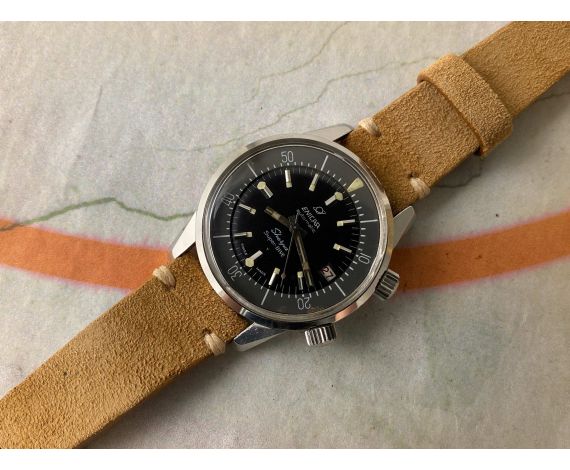
The initial 1957 advertising referred to the word Sherpas above and below and Everest, see below : The watertight case led to the creation of a family of Sherpa Dive watches from the Seapearl line. Enicar also proved the watertight capacity of their watches by attaching an Ocean Pearl to the keel of the sailing ship Mayflower II as it crossed the Atlantic in 1957. Over 100 different Enicar Sherpa watches were introduced in the following decade, becoming their most famous brand. It persisted longer on the case engraving. Within a year or two, the word Sherpas was dropped, particularly from the dials of watches. A black dialled automatic Enicar with the Dauphine hands of the period is shown lower below.Ī turtle lugged Enicar Thermograph of 1955 is shown below, and this feature was used on some watches used by the party.Įnicar seized on this publicity by registering the word Sherpa on 6 November 1956 and branding their “explorer” watches Sherpas or Sherpa later that year. The automatic movement was perhaps either an Elsa Bidynator HM1560 movement or an AR1034 (AS1361N) used in other Enicar watches of the period. The earliest known Seapearl marked (back and/or dial) model watch with the bayonet type compressor case with EPSA STOP marking is dated 10-55. One key to the success of the Enicar Seapearl model was the use of the Swiss patent #98243 Bayonet type closure compressor case made by the Ervin Piquerez SA (EPSA) company. Perhaps some expedition members were wearing Enicar Seapearl automatic watches.īelow is a photo of the 1956 Swiss expedition member Ernst Reiss, with his black faced, turtle lugged Enicar.

This was only the second time the summit of Everest was reached. On May 18, 1956, a Swiss expedition reached the summit of the Himalayan Lhotse Mountains (8516m) and the bordering summit of Mount Everest (8848m) on May 23, 1956. Current consensus is that the expedition used automatic Seapearl watches, but this is not conclusive. The Swiss team led by Albert Eggler consisted of Wolfgang Diehl, Hans Grimm, Hansrudolf von Gunten, Eduard Leuthold, Fritz Luchsinher, Jürg Marmet, Fritz Müller, Ernest Reiss, Dolf Reist, Adolf Reist and Ernst Schmied and twenty-two Sherpas.Īlbert Eggler’s book mentions Enicar automatic watches, some of them fitted with a thermometer. Enicar Seapearl watches accompanied the Swiss expedition to the top of Lhotse and Everest in the Himalayas in May 1956. In the late 1950’s Enicar began supplying watches to mountain climbers and other sportsmen and adventurers as a marketing exercise. The company also used movements from other manufacturers, including Valjoux, Adolph Schild (AS), and Lemania. The watch is a turtle lugged Seapearl.Įnicar’s own automatic movement, Calibre 1125, appeared in 1959. Enicar also helped develop a water-resistant case with an unusual bayonet back, introducing it as the Seapearl in 1955.ġ957 advertisement featuring Sherpas and Ultrasonic. Their movements were quite accurate as well, with Calibre 1010 winning chronometer certification by the NeuchâtelObservatory for the first time in 1954. The company had begun producing their own movements by then, with as many as 70,000 produced annually in the early 1950s. This eliminated the need for regular oiling.

The company then boasted that their movements were cleaned in a laboratory during manufacture, leading to the Ultrasonic brand found on many watches in the 1950s and 1960s. ENICAR SHERPA HISTORY: THE STORY BEHIND THE SHERPA NAMEĮNICAR SHERPA HISTORY: THE STORY BEHIND THE SHERPA NAMEĪfter World War II, under the leadership of Ariste Racine, Jr., Enicar modernized and expanded production to a new factory in 1953.


 0 kommentar(er)
0 kommentar(er)
